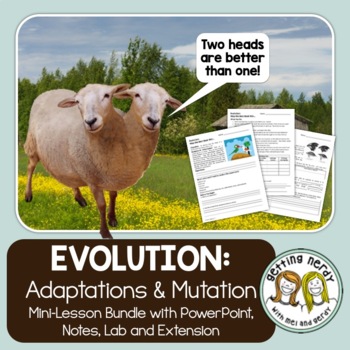Adaptations, Mutations and Natural Selection - Evolution PowerPoint and Handouts
- Zip
What educators are saying
Description
May the best beak win as students fight for survival of the fittest in this lesson about mutation, adaptation and evolution by natural selection. Charles Darwin would be so proud!
WHAT'S INCLUDED in this 1-2 DAY LESSON:
• 19 EDITABLE PowerPoint slides with bellwork, instructions, notes and embedded answer keys to handouts
• 6 NON-EDITABLE PDF pages that align with the PowerPoint
• Mutation Bird Beak Lab Activity
STUDENTS WILL:
• Learn about how mutation leads to adaptation and Charles Darwin's contributions to the theory of evolution
• Demonstrate evoution by natural selection as they partipcate in a bird beak lab
THIS PRODUCT IS ALSO FOUND IN OUR:
• Evolution - PowerPoint, Handouts, INB, Task Cards, Word Wall
• Life Science Biology Curriculum Bundle
CHECK OUT OUR OTHER EVOLUTION PRODUCTS :
• Evolution Bundle - Science Centers / Lab Stations
• Evolution - Interactive Notebook
SEE HOW THIS LESSON ALIGNS WITH THE NGSS, TEKS or GSE
Because we have created many of our own graphics or have purchased licenses to other graphics with permission, we cannot offer our resources in editable format unless otherwise stated.
TERMS OF USE (TOU):
All rights reserved by GETTING NERDY®️
• This product is to be used by the original purchaser only
• Intended for classroom and personal use only
• Copying for more than one teacher, classroom, department, school, or school system is prohibited
• This product may not be distributed or displayed digitally for public view
Failure to comply is a copyright infringement and a violation of the Digital Millennium Copyright Act (DMCA). Clipart and elements found in this PDF are copyrighted and cannot be extracted and used outside of this file without permission or license.
Evolution: Adaptations, Mutations and Natural Selection © 2012 to present Getting Nerdy ®️ All Rights Reserved
www.gettingnerdyscience.com





